When it comes to gorgeous, windswept islands, few can match the sublime beauty of the Orkney Islands. Located north of Scotland’s mainland, the Orkneys are home to an incredible array of outdoor activities and surprisingly deep history.
Whether you want to explore the islands’ Norse heritage, learn about the region’s World War II history, or enjoy the delicious local culinary scene, there are endless amazing things to do in the Orkneys.
This comprehensive guide will help you plan your visit, so settle in with a cuppa or dram and read on about some of the best things to do on the Orkney Islands.

The Orkney Islands
The Orkneys are a group of around 70 islands off the north coast of Scotland. Sixteen of the islands are inhabited by more than sheep, including the Mainland, the largest Orkney island and home to its two major towns, Kirkwall and Stromness.
My first glimpse of the islands was on one of the passenger ferries to the Orkneys, departing from Gills Bay in Caithness on the Scottish mainland on a blustery October day. After an hour’s ferry ride across the North Sea, we docked in St. Margaret’s Hope, on the island of South Ronaldsay, where we began our encounter with the treeless hills, stunning beaches, fascinating historic sites, and the friendly people that make Orkney a fantastic place to visit.
Note about transportation: You’ll find there’s plenty of things to do in Kirkwall, the capital town of the Orkneys, but it’s a good idea to rent a car when visiting Orkney so you can explore the islands beyond Mainland. Many of the best Orkney attractions are outdoors and the weather conditions can be changeable, so be prepared for every kind of wild weather. See more transportation tips at the end of this article.
13 outstanding things to do on the Orkney Islands
Go back in time at Skara Brae
The fascinating Neolithic sites and settlement of Skara Brae lies on the Bay of Skaill on the island of Mainland, the largest of the Orkney Islands. It is one of the most perfectly preserved Stone Age villages in Europe, and was uncovered by a storm in 1850 and is one of the four sites that now make up the “Heart of Neolithic Orkney” UNESCO World Heritage Site.
The ten stone-built houses of Skara Brae were occupied between 3200 BC and 2200 BC, which makes them older than the Great Pyramids of Giza. The houses contain stone hearths, cupboards and beds, as well as artifacts including knives, beads and bowls made of whalebone, orca teeth, and walrus ivory.
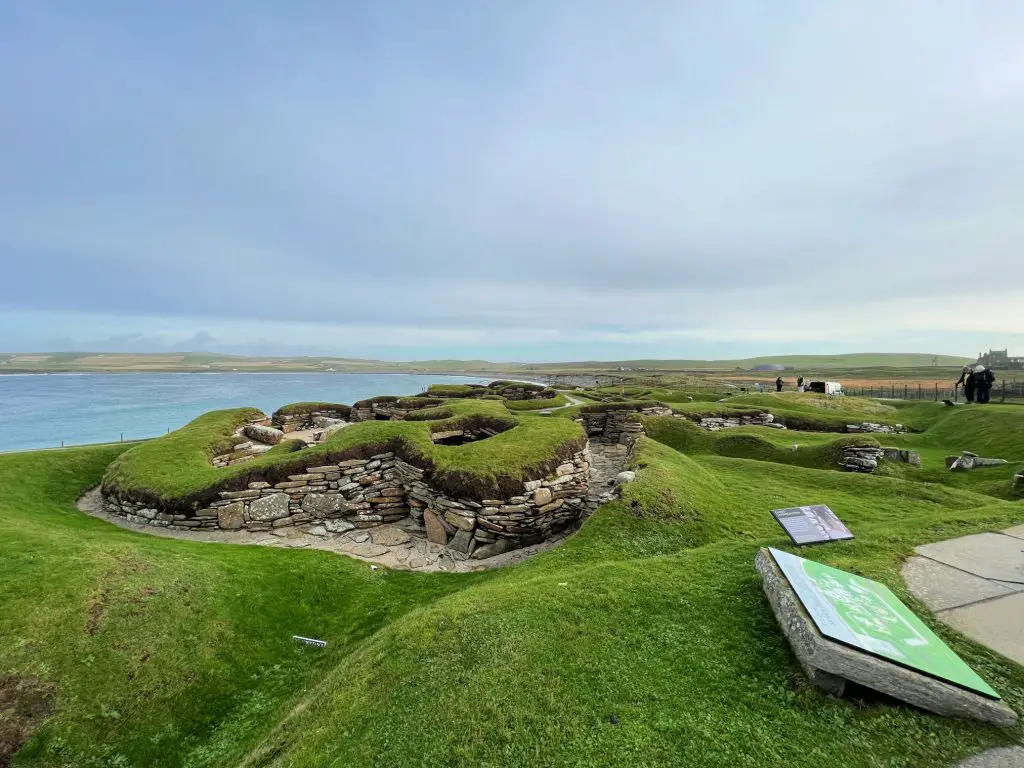
It’s not fully known why the village was abandoned. Archaeologists suspect the sea moved inland and eroded the site and the surrounding farmland, making life difficult for residents.
Skara Brae Prehistoric Village is under the care of Historic Scotland. Visitors can tour the outdoor archaeological site on a guided tour year-round. There is an interesting indoor exhibition and short film explaining the settlement’s history.
Check the Skara Brae website for unexpected closures before your visit.
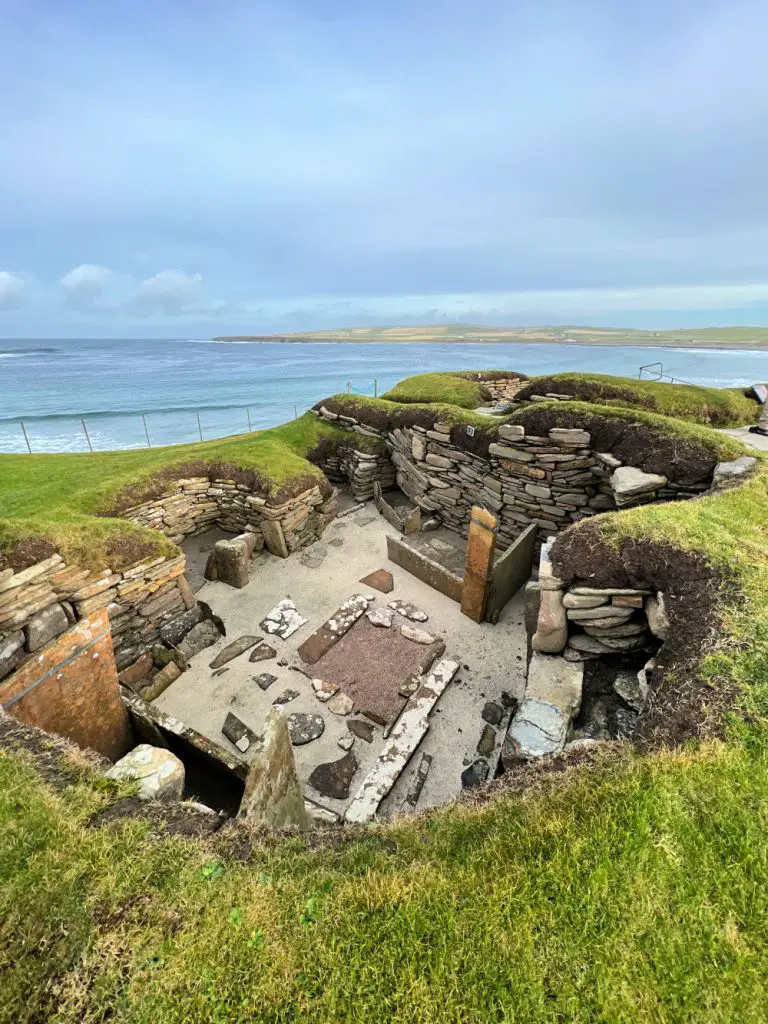
Use the map below to search for hotel and short-term rental options
Hike to the Old Man of Hoy
The Old Man of Hoy is a red sandstone sea stack that stands off Rackwick Bay on the island of Hoy’s west coast. It measures 137m tall, making it one of Britain’s tallest sea stacks.
The Old Man is thought to have appeared around 250 years ago, as the soft rock surrounding the stack eroded. The sandstone’s fragile nature and constant exposure to the elements mean that the Hike Yesnaby Cliffs: Lace up your hiking boots and embark on a journey along the dramatic Yesnaby Cliffs. Experience the raw power of the North Atlantic as waves crash against the rugged coastline, and be rewarded with breathtaking views of sea stacks and natural arches is very unstable and could collapse into the sea at any time.
Despite this danger, around 50 people scale the Old Man each year. A much safer option is to admire the view of this spectacular landmark from the shore.
A walking track from Rackwick Bay follows the Hoy coastline to a nearby vantage point. You’ll get a great view of the Old Man from here. The trek is approximately 10 km/6 mile out and back. Pack a picnic to enjoy while viewing the stack and the ocean beyond.
You can continue northwards to St John’s Head, which at 335m tall is the UK’s highest vertical sea cliff. The Head is also viewable from the vantage point at the Old Man of Hoy.
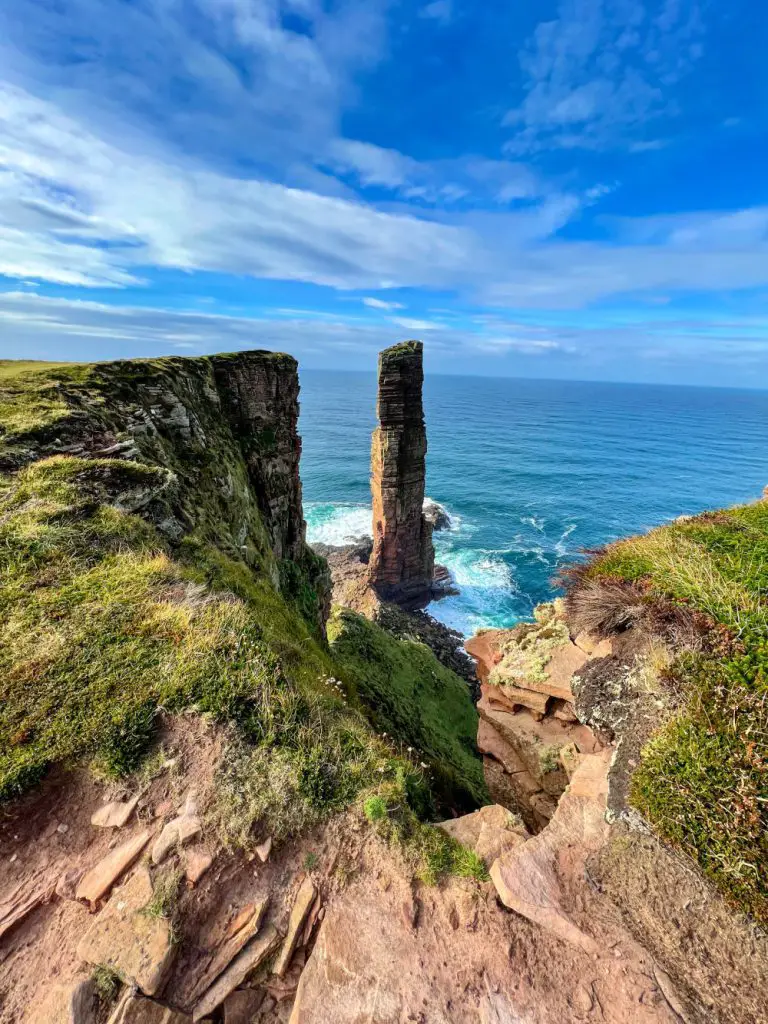
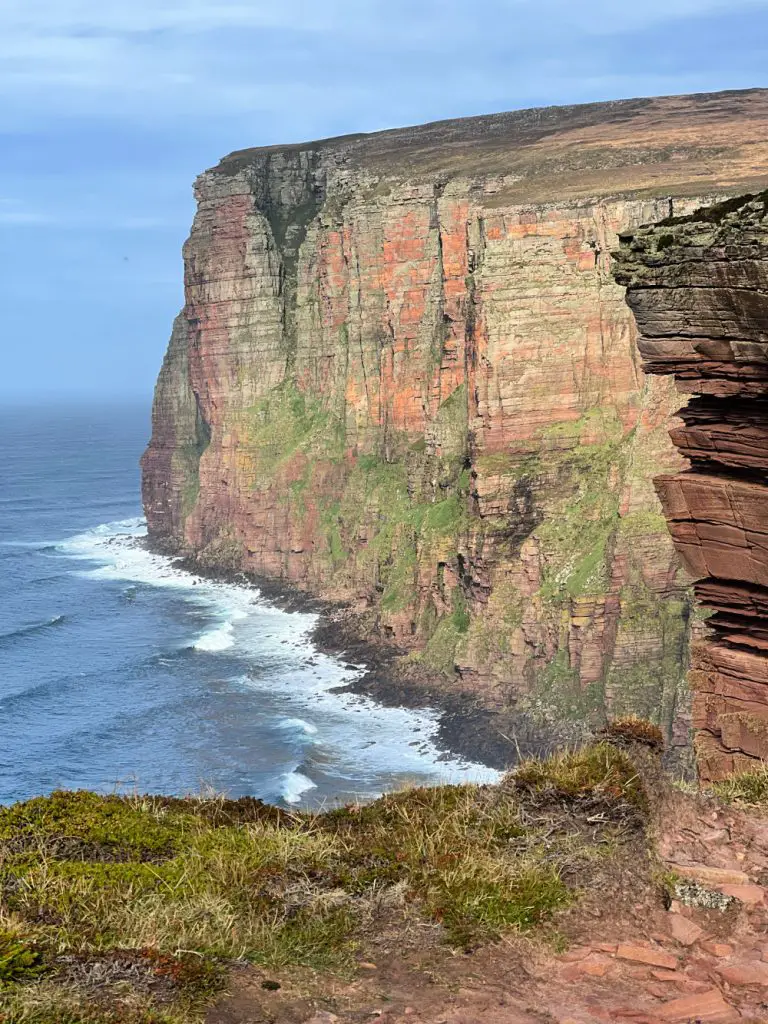
Visit Stromness
There’s plenty to see and do in Stromness, the second largest town in Orkney. It’s a history lover’s delight, with reminders of the island’s heritage down every flagstone-lined street.
You can learn about the town’s history in the small but fascinating Stromness Museum. Including an excellent exhibition about Stromness’ favorite son, Dr. John Rae and his time in Arctic Canada. Take a Stromness Hometown audio walking tour. Or if you’re a keen scuba diver, explore the wartime wrecks in Scapa Flow.
Every May, Stromness plays host to the Orkney Folk Festival. And fans of the blues should visit Orkney later in the year when the Orkney Blues Festival takes over Stromness.
Art lovers can visit the Pier Arts Centre, galleries and artists’ studios, while the annual Stromness Shopping Week gala and many independent boutiques make the town a great place to shop til you drop. The Gala has been taking place since 1948 and is held every July.

Experience the Ring of Brodgar
About five miles northeast of Stromness, you’ll find one of the UK’s most notable prehistoric ancient monuments. The Ring of Brodgar Stone Circle and Henge is a massive stone circle surrounded by a large circular ditch. It dates back to around 3,000 BC.
Thirty-six of the original 60 stones in the Ring of Brodgar remain standing today. The stones are up to 4.7 m tall and the stone circle measures over 100m across. This makes the Ring of Brodgar one of the UK’s largest stone circles.
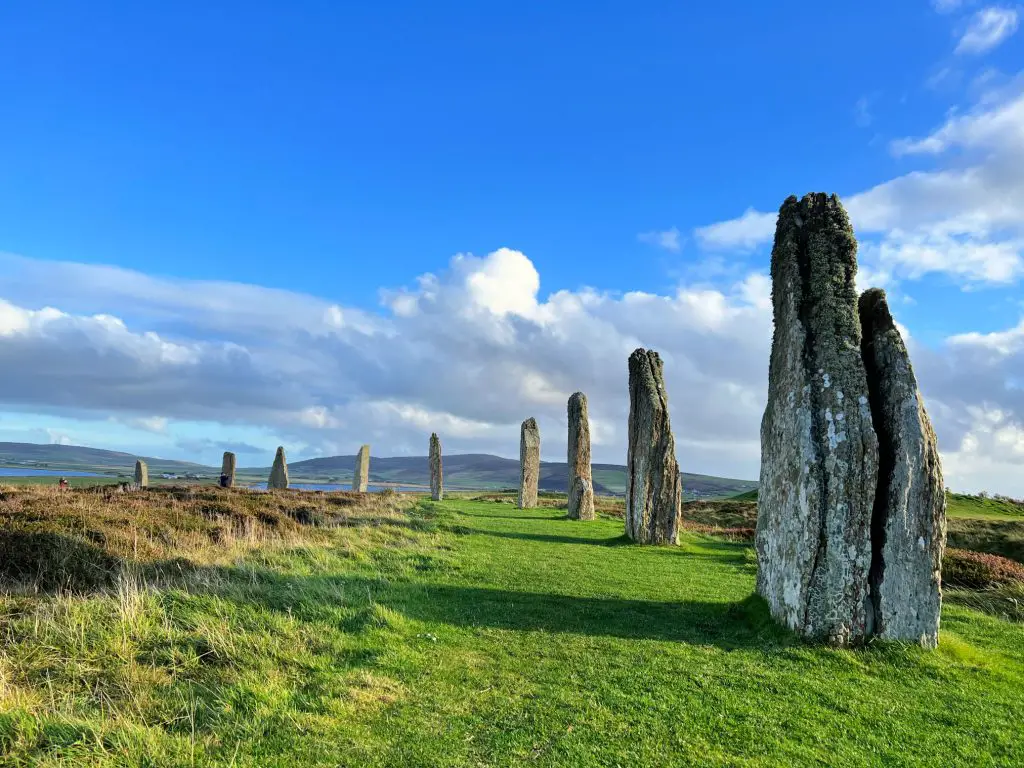
While Outlander fans like myself had fun wishing and failing to be transported across the space-time continuum, Brodgar’s stones are magical. Each large stone edifice is from a different area in the Orkneys. Archaeological digs have never turned up bones, food remnants or artifacts in or around the Ring. So the Ring’s purpose remains a true mystery.
The Ring of Brodgar is part of the Heart of Neolithic Orkney World Heritage Site, along with Skara Brae, Maeshowe Chambered Cairn, and The Stones of Stenness. The site is open all year round. You can explore on your own or join a Historic Scotland guided tour.
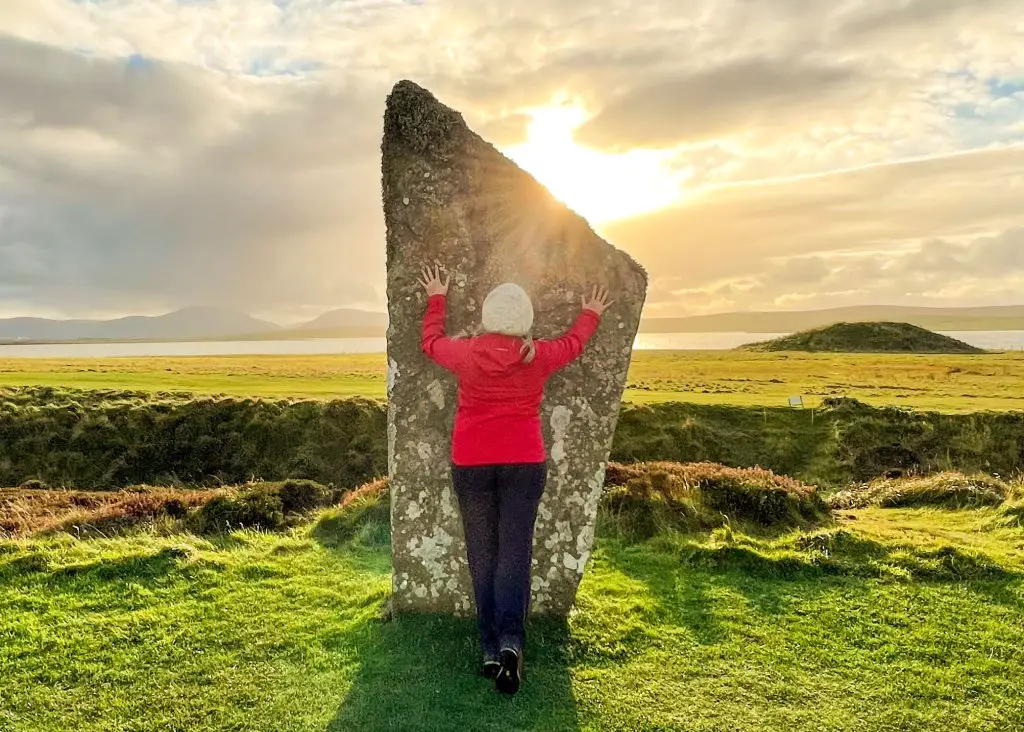
Explore the Orkneys’ hiking paths and trails
The islands of Orkney are a fantastic place for hiking and walking. You’ll find may hiking trails on the Orkney Islands with varying difficulty levels.
Although the isles of Orkney lie just 10 miles from the mainland coast, the landscape has an otherworldly feel. Most of the islands are low-lying and covered in fields and heather. You’ll find more dramatic terrain on the rugged isle of Hoy, with the Old Man of Hoy and spectacular St John’s Head sea cliffs.
Another favorite trek is the trail along the dramatic Yesnaby Cliffs. Experience the impressive power of the North Atlantic as waves crash against the rugged coastline, and be rewarded with breathtaking views of sea stacks and natural arches.
One of my favorite hikes on Orkney is at Mull Head, the furthest point of Deerness. The grassy clifftop route offers one of the finest coastal circuits on Mainland Orkney. The route includes a dramatic gloup (a vertical blowhole), impressive cliffs and wonderful ocean views.

In addition to the weather, which can whip up to a gale in an instant, the highlight is the narrow path leading out onto the Brough of Deerness. The walk can be extended by linking up with the Covenanters’ Memorial route.
Of course, Scottish weather can be unpredictable, and the weather in the Orkneys is no exception to this. If you go hiking in the Orkneys, always take the usual precautions. Dress in layers, take a backup method of navigation and let someone know your planned route and return time.
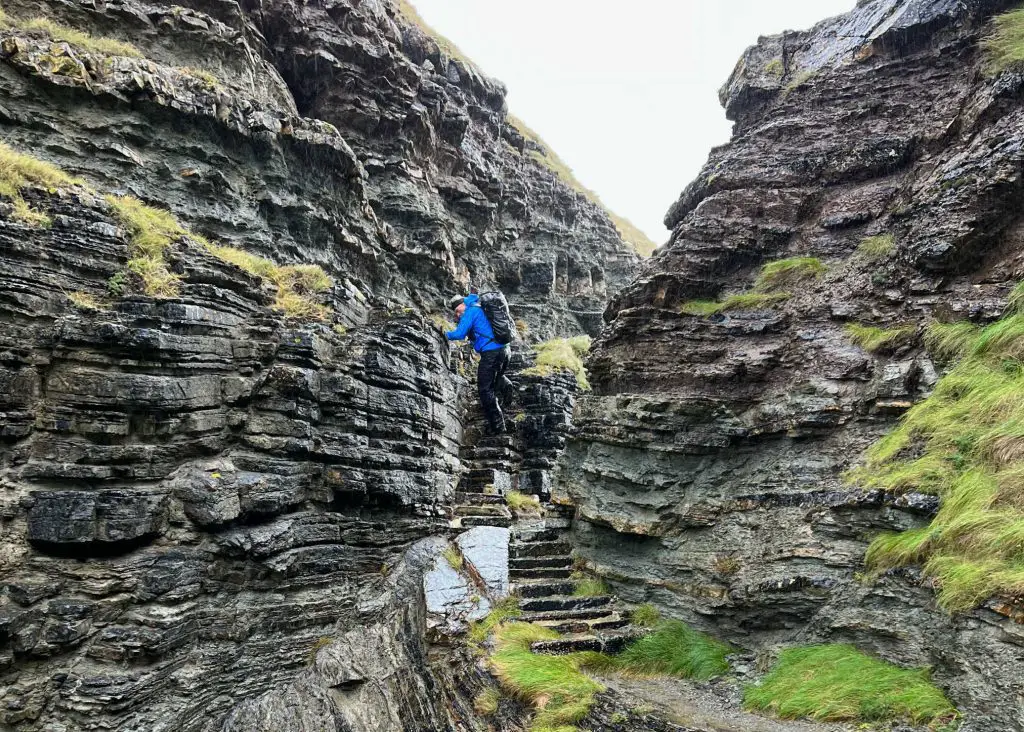
Visit Rousay Island
The small island of Rousay lies about 2 miles to the north of Mainland, the largest of the Orkney Islands.
There are over 150 ancient sites on Rousay including the Iron Age site at Midhowe Broch and the 5000-year-old Midhowe Chambered Cairn. The island’s archaeological importance has led to it being known as the “Egypt of the north”.
Apart from its archaeological wonders, there are plenty more things to do in Rossay. The island offers great hiking trails and the 14-mile-long main road around the island is a challenging cycle route with breathtaking views. You could also visit the RSPC Scotland reserve at Trumland. Here, you might spot red-throated divers, short-eared owls, merlins, and more.
Inter-island travel in the Orkneys is with Orkney Ferries. Routes include from the Mainland to Hoy, Rousay and the neighboring islands of Egilsay, Wyre and North Ronaldsay.

Tour the Maeshowe Chambered Cairn
Maeshowe is a Neolithic chambered tomb built around 5,000 years ago. It’s considered to be northwest Europe’s finest surviving Neolithic building.
The cairn looks like a large grassy mound from the outside. But inside the large space there is a ceremonial chamber. No bones were ever found inside Maeshowe, so it’s suspected that the cairn was a ceremonial gathering place for local farmers.
The 10-meter-long passageway to the chamber was built using massive sandstone slabs. Ther are magnificent standing stone guards each corner of the central chamber. If you look up at some of the cairn rafters, you’ll notice Viking runes dating back to the 12th century.
This ‘graffiti’ is from Vikings who sought shelter in the cairn from a brutal storm. Apparently, they whiled away the days writing runes declaring their valor. And complaining about how ‘the young Vikings of today’ weren’t as tough as they were. Some things never change.

Guided tours of Maeshowe Chambered Cairn are available all year round. If you visit Maeshowe on either side of the winter solstice, between the end of November and the middle of January, be sure to book the 2 PM tour. You’ll be able to watch as the setting sun aligns perfectly with a small window in the cairn’s central chamber.
Visitor numbers are limited. Book your visit to Maeshowe Chambered Cairn in advance to avoid disappointment.
Use the map below to search for hotel and short-term rental options
View the Lord Kitchener memorial
On June 5th 1916, in the middle of World War I, HMS Hampshire left the wartime Royal Navy base in Scapa Flow. It sank in mysterious circumstances off the west coast of Orkney.
There were only 12 survivors and over 700 men lost their lives. Among them was Lord Kitchener, Britain’s Secretary of War, whose face had been immortalized on the ‘Your Country Needs You’ army recruitment posters.
In 1926 the people of Orkney unveiled the 48 ft high Kitchener Memorial, which was financed through public donations. This stone tower stands on the coast of RSPB Scotland Marwick Head nature reserve alongside a wall which bears the names of all 737 men lost on board HMS Hampshire.
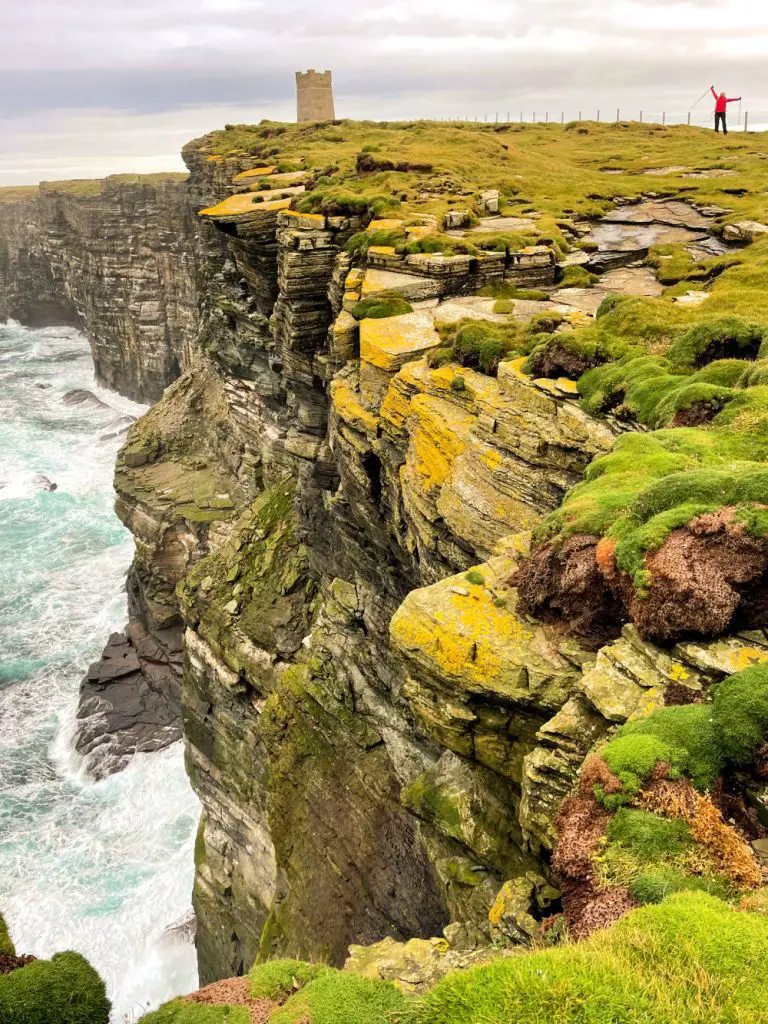
Explore St Magnus Cathedral
The stunning Romanesque and Norman architecture of St Magnus Cathedral towers over Kirkwall, Orkney’s main town. Although it’s technically no longer a cathedral, St Magnus is known as the UK’s most northerly cathedral and also has the nickname of the ‘Light in the North’.
Work began on the cathedral in 1137, when the Orkneys were under Viking rule, and took 300 years to complete. The Norwegian Earl of Orkney, Rögnvald Kali Kolsson, dedicated the building to his uncle and previous Earl, Magnus Erlendsson. Erlendsson was martyred on Mainland and sainted in the 12thcentury.
St Magnus Cathedral is open to visitors from Monday to Saturday. Guided tours are available and pre-booking is essential. Or just download the St Magnus Cathedral app for a self-guided tour.

Stroll the streets of Kirkwall
Kirkwall is the largest town in the Orkney Islands and lies on Mainland, the largest island in the Orkneys. The town was built on the site of a Norse town dating back around 1000 years and its name comes from the Norse name Kirkjuvágr, meaning “Church Bay”.
You’ll see evidence of Orkney’s fascinating history around every corner. From the Iron Age ‘Grain Earth House’ to the Norse-built St Magnus Cathedral and the 17th and 18th century houses designed in the local style.
The Orkney Museum on Broad Street has a fascinating range of exhibits and artifacts. Enjoy delicious island spirits on a gin tasting tour at the Orkney Distillery. Tankerness House Gardens is the perfect place to enjoy a relaxing stroll or soak up the summer sun, or you could just sit and watch the boats sailing in and out of Kirkwall Bay.
Discover the Orkneys’ Viking past
The islands of Orkney were a crucial seat of power in the Norse empire, and you’ll see the legacy of Orkney’s Viking past throughout the islands.
Vikings settled the islands in the late 8th century and many Orcadians (residents of the Orkneys) are descended from these original settlers and spoke a version of Orcaidan Norse. Orkney became a strategic base and an important center for trade until the islands were eventually given to the Scottish Crown in 1468.
The Orkney’s Norse heritage can be seen in place names and archaeological sites. Kirkwall Airport’s sign is written in Norse runes, and the 55-mile St Magnus Way is a walking route that takes in many Norse sites.
The Nordic Cross-style Orkney Flag is flown more often than the Scottish Saltire in the Orkney Islands. And if you visit Kirkwall on May 17th, you’ll also see Norwegian flags flying as the town celebrates Norway’s national day with a procession.
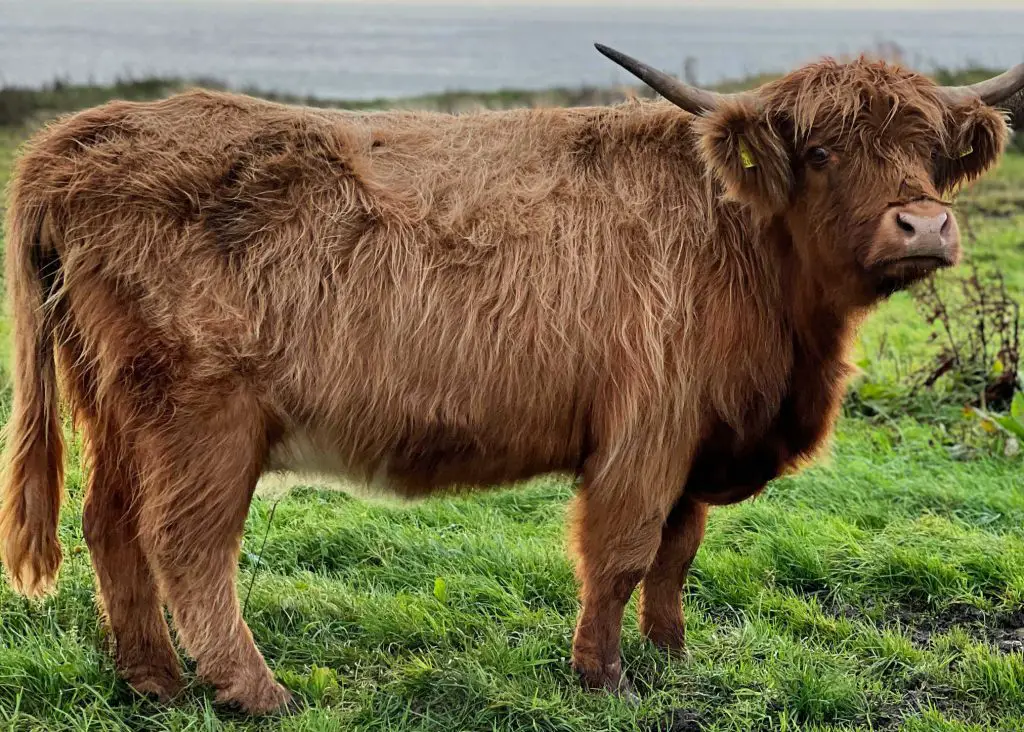
World War II Churchill Barriers + Italian Chapel
A product born of World War II, the Churchill Barriers are four causeways in the Orkney islands that link the Orkney Mainland in the north to the island of South Ronaldsay via Burray and the two smaller islands of Lamb Holm and Glimps Holm.
German U-boat activity in Scapa Flow and the sinking of HMS Royal Oak more than 80 years ago set in motion plans by then First Lord of the Admiralty, Winston Churchill, to build the four concrete causeways to block off the eastern approaches to the naval anchorage of Scapa Flow.

Work on the barriers began in May 1940 and was completed four years later. Much of the labor for this massive engineering project was provided by Italian prisoners of war, held in a camp on the island of Lamb Holm.
During their time in Orkney, these prisoners built another remarkable structure, transforming a basic Nissen hut into a lovely and calm symbol of peace, the famous Italian Chapel.
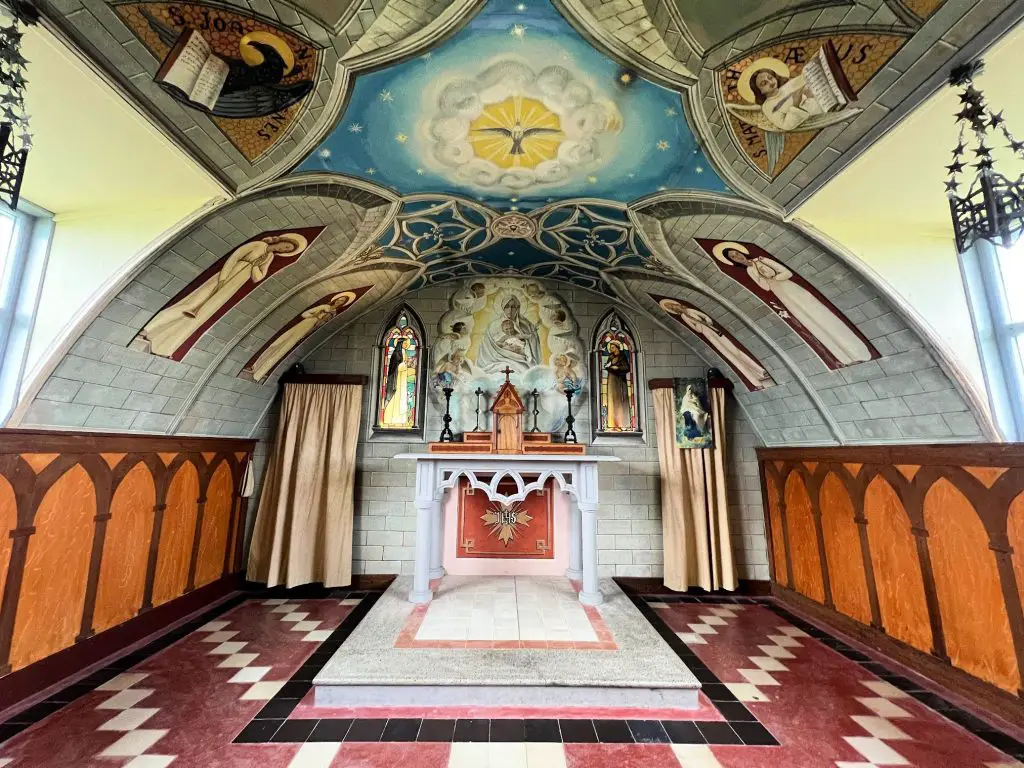
Officially opened in May 1945, the barriers are now causeways connecting the Orkney Mainland with the isles of Lamb Holm, Glimps Holm, Burray and South Ronaldsay.
It’s a fascinating road trip. You can still see the wrecks of blockships previously used to block the channels into Scapa Flow.
How to get to and around the Orkney Islands
Getting to and around the Orkney Islands typically involves a combination of transportation methods, including ferry, air travel, and local transportation.
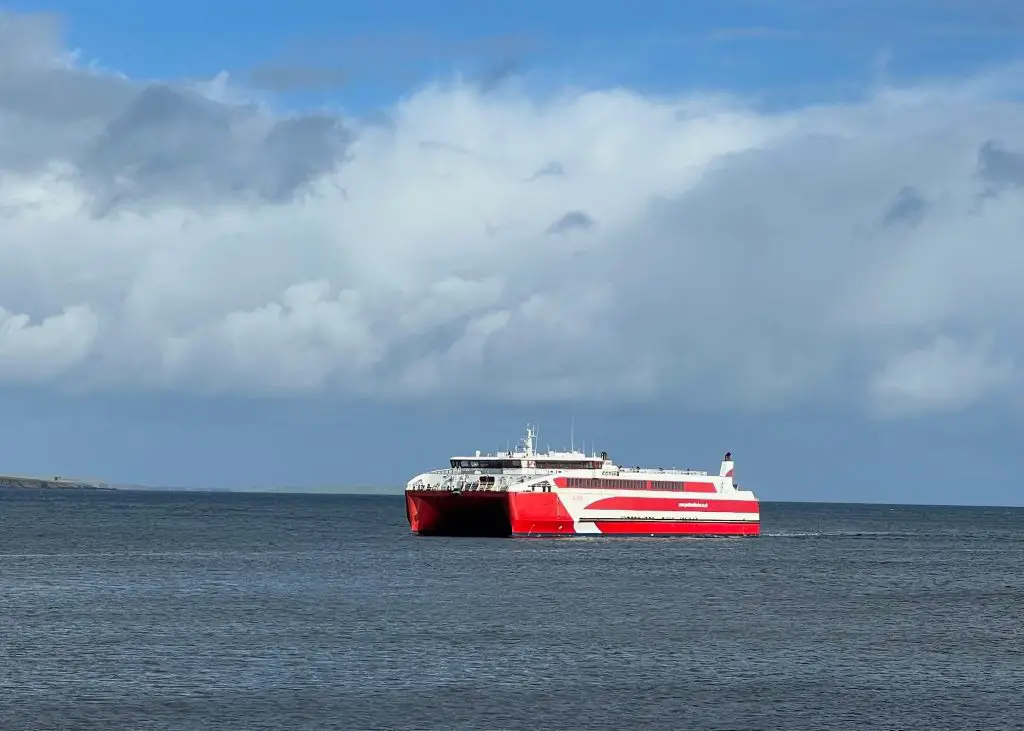
Getting to the Orkney Islands
1. By Air: Kirkwall Airport (KOI): The largest airport on the Orkney Islands is located near Kirkwall, the main town. You can fly to Kirkwall Airport from various Scottish cities, including Aberdeen, Edinburgh, Glasgow, and Inverness. There are also flights from the Scottish mainland to some of the other Orkney Islands. Loganair is the primary airline serving the region.
2. By Ferry:
Northlink Ferries: Northlink Ferries operate passenger and car ferries from Aberdeen to Lerwick in the Shetland Islands, with a stop in Kirkwall on Orkney en route. This is a scenic way to reach Orkney by sea. The journey from Aberdeen to Kirkwall takes around 6-7 hours.
Pentland Ferries: This company operates a passenger and car ferry service between Gills Bay on the Scottish mainland (near John O’Groats) and St. Margaret’s Hope on South Ronaldsay, one of the Orkney Islands. The crossing is shorter and takes approximately 1 hour.
Getting around the Orkney Islands
1. Local Buses: Orkney has a comprehensive bus network that connects many of the islands’ main towns and attractions. Buses are a convenient and cost-effective way to get around.
2. Car Hire: Renting a car is a popular choice for exploring the Orkney Islands independently. There are several car rental companies in Kirkwall and at the airport. Be sure to book in advance, especially during the tourist season.
3. Cycling: The Orkneys offer excellent opportunities for cycling, with scenic routes and relatively quiet roads. Some accommodations may offer bicycle rentals.
4. Taxis: Taxis are available in Kirkwall and other larger towns. You can also pre-book taxis for specific journeys or tours.
5. Tours and Excursions: Various companies offer guided tours and excursions to popular attractions and historical sites on the islands. I traveled with Wilderness Scotland, which provided a knowledgeable and excellent tour of the Orkneys, including many of its most popular sites and highlights.
6. Ferries between Islands: To explore multiple islands, you may need to take local ferries. Companies like Orkney Ferries operate these services, connecting the main islands and providing access to smaller ones.
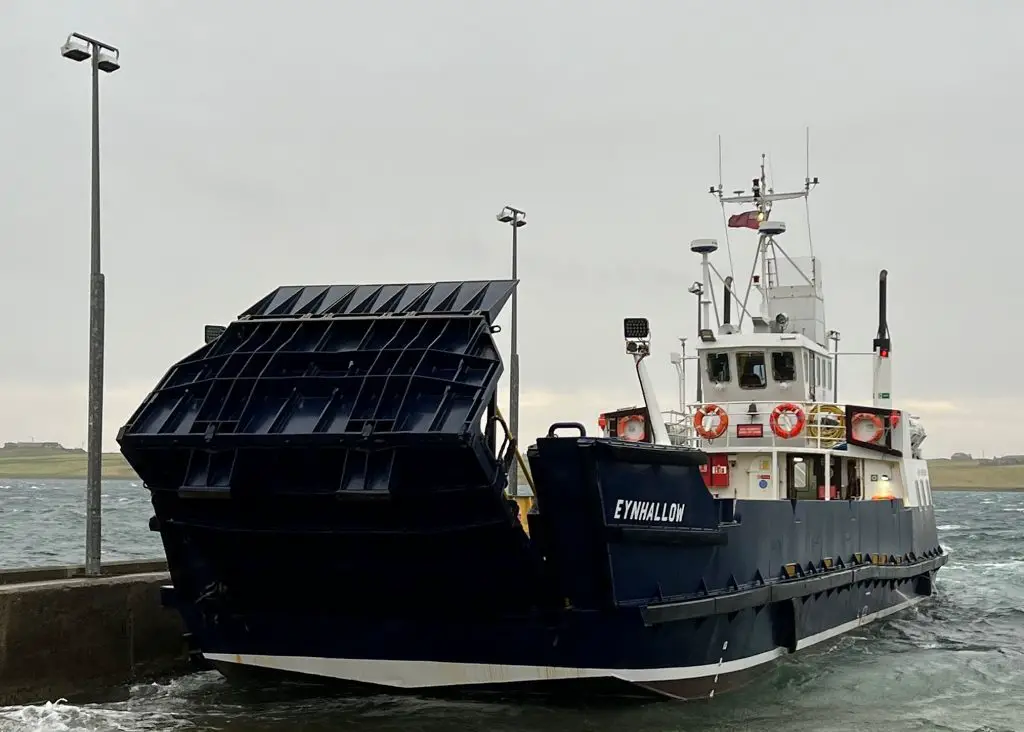
8. Inter-Island Flights: In addition to the mainland, there are scheduled inter-island flights that can be used to reach more remote or smaller islands within the Orkney archipelago.
9. Hitchhiking: Hitchhiking is relatively common and considered safe in Orkney. Locals are often friendly and willing to provide rides to visitors, but exercise caution as you would anywhere else.
Pin for Later
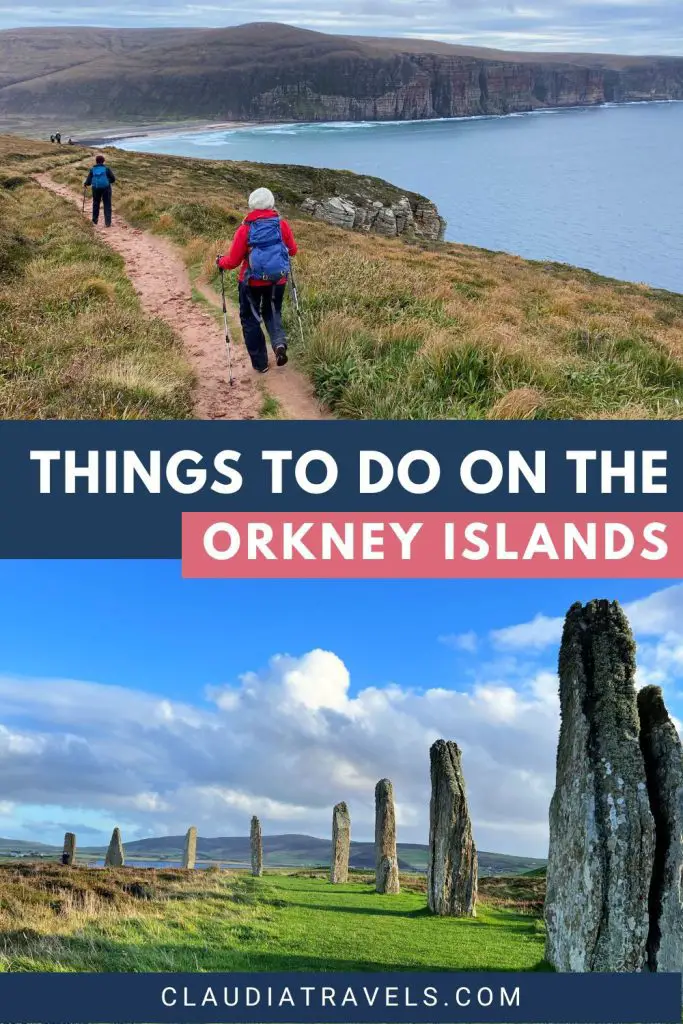

Photo credits: Claudia Laroye
Disclosure: The writer thanks Wilderness Scotland for hosting her visit to the Orkney Islands. As always, her opinions and love of windswept islands and delicious gin are honest and her own.
- How to spend an unforgettable two days in Venice, Italy - April 25, 2024
- The Best Carry-on Luggage 2024 - April 15, 2024
- 9 essential tips for surviving road trips with teenagers - April 6, 2024

